Enterprise Resource Planning System: Analysis and Review Report
VerifiedAdded on 2020/03/16
|15
|3590
|44
Report
AI Summary
This report delves into the realm of Enterprise Resource Planning (ERP) systems, examining their roles, benefits, and drawbacks. It begins with an abstract providing a concise overview of ERP's significance for business competitiveness and efficiency, followed by an introduction that defines ERP technology as integrated computer applications. The report includes a SWOT analysis of RealEstate.com.au considering the implementation of an ERP system, outlining strengths, weaknesses, opportunities, and threats. It also discusses the roles and purposes of ERP, emphasizing its importance in various business functions. Furthermore, the report explores the advantages of ERP implementation, such as cost reduction and improved customer service, while also addressing drawbacks like technical and information quality issues. A literature review is included, covering the growth of ERP systems over time. This report provides a comprehensive analysis of ERP systems and their impact on business operations.

Running head: ENTERPRISE RESOURCE PLANNING 1
Enterprise resource planning
Name:
Institution Affiliation:
Enterprise resource planning
Name:
Institution Affiliation:
Paraphrase This Document
Need a fresh take? Get an instant paraphrase of this document with our AI Paraphraser

ENTERPRISE RESOURCE PLANNING 2
Abstract
Enterprise resource planning system is an investment which helps a company to compete and
also perform efficiently. This consequently, provides a framework for the collection of a suitable
ERP system. The significant framework ought to the methodically construct the objectives of the
ERP system to manage to support on the goals of the business as well as the strategies of the
enterprise. Moreover, it can help in the identifying of the appropriate attributes as well as
consistent evaluation standards to alleviate the group decision process. In this research it will
discuss the roles and the purpose of the enterprise resource planning system, benefits as well as
the drawbacks of ERP implementation, and the literature review of ERP system and the current
trends in ERP system.
Index terms: enterprise resource planning (ERP)
Abstract
Enterprise resource planning system is an investment which helps a company to compete and
also perform efficiently. This consequently, provides a framework for the collection of a suitable
ERP system. The significant framework ought to the methodically construct the objectives of the
ERP system to manage to support on the goals of the business as well as the strategies of the
enterprise. Moreover, it can help in the identifying of the appropriate attributes as well as
consistent evaluation standards to alleviate the group decision process. In this research it will
discuss the roles and the purpose of the enterprise resource planning system, benefits as well as
the drawbacks of ERP implementation, and the literature review of ERP system and the current
trends in ERP system.
Index terms: enterprise resource planning (ERP)

ENTERPRISE RESOURCE PLANNING 3
1. Introduction
The enterprise resource planning technology are basically the computer applications that are
made up of numerous components for instance the human resources , sales , manufacturing in
addition to finance offering of the cross organization integration of the data via the embedded
process of the business (Leon, 2014). The EPR software package can be customized in order to
cater for various needs of the business. When an organization utilize the ERP system in the
industry, it would serve as an important aspect towards the development in the corporate use of
the IT.
The implementation of the ERP programs could impact the users at different levels of the
organization as it cuts all across the business function units. Users range from the top
management to the low level who uses the system in their daily operations (Leon, 2014). It is
important to understand that the ERP is an industry driven concept as well as systems, and it has
been accepted by various industry as the practical solution when it comes to achieving the
integrated enterprise information systems.
Companies today confront on the new markets, new competition as well as increase in the
expectations of the customers. Organizations today has been able to re-engineer practices as well
as procedures to become a lot more responsive to the clients and the competition. The
effectiveness of any enterprise depends upon the flow of the data across the complete supply
chain; such from the client to the manufacturer to the supplier (Leon, 2014). The enterprise
resource planning models , have grown to be vital specifics technology that have been used by
plenty of the business enterprise today , to achieve the competitive upper hand against the
competitors ( Tao , Cheng , Zhang & Nee , 2017 ) . Nevertheless, this decision solely plausible
when the execution has been coupled to the process of re-engineering (Bento & ISTM, 2015).
1. Introduction
The enterprise resource planning technology are basically the computer applications that are
made up of numerous components for instance the human resources , sales , manufacturing in
addition to finance offering of the cross organization integration of the data via the embedded
process of the business (Leon, 2014). The EPR software package can be customized in order to
cater for various needs of the business. When an organization utilize the ERP system in the
industry, it would serve as an important aspect towards the development in the corporate use of
the IT.
The implementation of the ERP programs could impact the users at different levels of the
organization as it cuts all across the business function units. Users range from the top
management to the low level who uses the system in their daily operations (Leon, 2014). It is
important to understand that the ERP is an industry driven concept as well as systems, and it has
been accepted by various industry as the practical solution when it comes to achieving the
integrated enterprise information systems.
Companies today confront on the new markets, new competition as well as increase in the
expectations of the customers. Organizations today has been able to re-engineer practices as well
as procedures to become a lot more responsive to the clients and the competition. The
effectiveness of any enterprise depends upon the flow of the data across the complete supply
chain; such from the client to the manufacturer to the supplier (Leon, 2014). The enterprise
resource planning models , have grown to be vital specifics technology that have been used by
plenty of the business enterprise today , to achieve the competitive upper hand against the
competitors ( Tao , Cheng , Zhang & Nee , 2017 ) . Nevertheless, this decision solely plausible
when the execution has been coupled to the process of re-engineering (Bento & ISTM, 2015).
⊘ This is a preview!⊘
Do you want full access?
Subscribe today to unlock all pages.

Trusted by 1+ million students worldwide

ENTERPRISE RESOURCE PLANNING 4
The utilization of the ERP system offers the capability of developing of most the primary
business applications which include all the areas and the levels of a business (Bi, Da Xu &
Wang, 2014). All the programs in the ERP suite usually share prevalent set of the data which is
often stored to the central database. It functions as the backbone for the whole strategy of
computing in the business, integrating on the essential business in addition to the management
processes to have the ability to provide a sky-level view of what exactly is going on in the
organization (Bi, Da & Wang , 2014 ) ) . An ERP system generally provides the functions for the
accounting along with the controlling, production and the materials management, the quality
management, sales and the distribution, human resources as well as the project management. In
this study, it is going to talk about the roles as well as intent behind the enterprise resource
planning system, advantages along with the drawbacks of ERP implementation, in addition to the
literature review of the ERP system and the current trends of ERP system.
1.1 SWOT analysis
SWOT Analysis
Organization: RealEstate.com.au Date: 3/10/2017
Description of current/new ICT service:
The organization is intending to adopt modern Enterprise planning system. This system is intended
reduce the cost of operations, as well as errors especially in the human resource, finance, and human,
supply and human resource department.
STRENGTHS
There is automation of the system. The system
WEAKNESSES
The system has a complex user interface
The utilization of the ERP system offers the capability of developing of most the primary
business applications which include all the areas and the levels of a business (Bi, Da Xu &
Wang, 2014). All the programs in the ERP suite usually share prevalent set of the data which is
often stored to the central database. It functions as the backbone for the whole strategy of
computing in the business, integrating on the essential business in addition to the management
processes to have the ability to provide a sky-level view of what exactly is going on in the
organization (Bi, Da & Wang , 2014 ) ) . An ERP system generally provides the functions for the
accounting along with the controlling, production and the materials management, the quality
management, sales and the distribution, human resources as well as the project management. In
this study, it is going to talk about the roles as well as intent behind the enterprise resource
planning system, advantages along with the drawbacks of ERP implementation, in addition to the
literature review of the ERP system and the current trends of ERP system.
1.1 SWOT analysis
SWOT Analysis
Organization: RealEstate.com.au Date: 3/10/2017
Description of current/new ICT service:
The organization is intending to adopt modern Enterprise planning system. This system is intended
reduce the cost of operations, as well as errors especially in the human resource, finance, and human,
supply and human resource department.
STRENGTHS
There is automation of the system. The system
WEAKNESSES
The system has a complex user interface
Paraphrase This Document
Need a fresh take? Get an instant paraphrase of this document with our AI Paraphraser
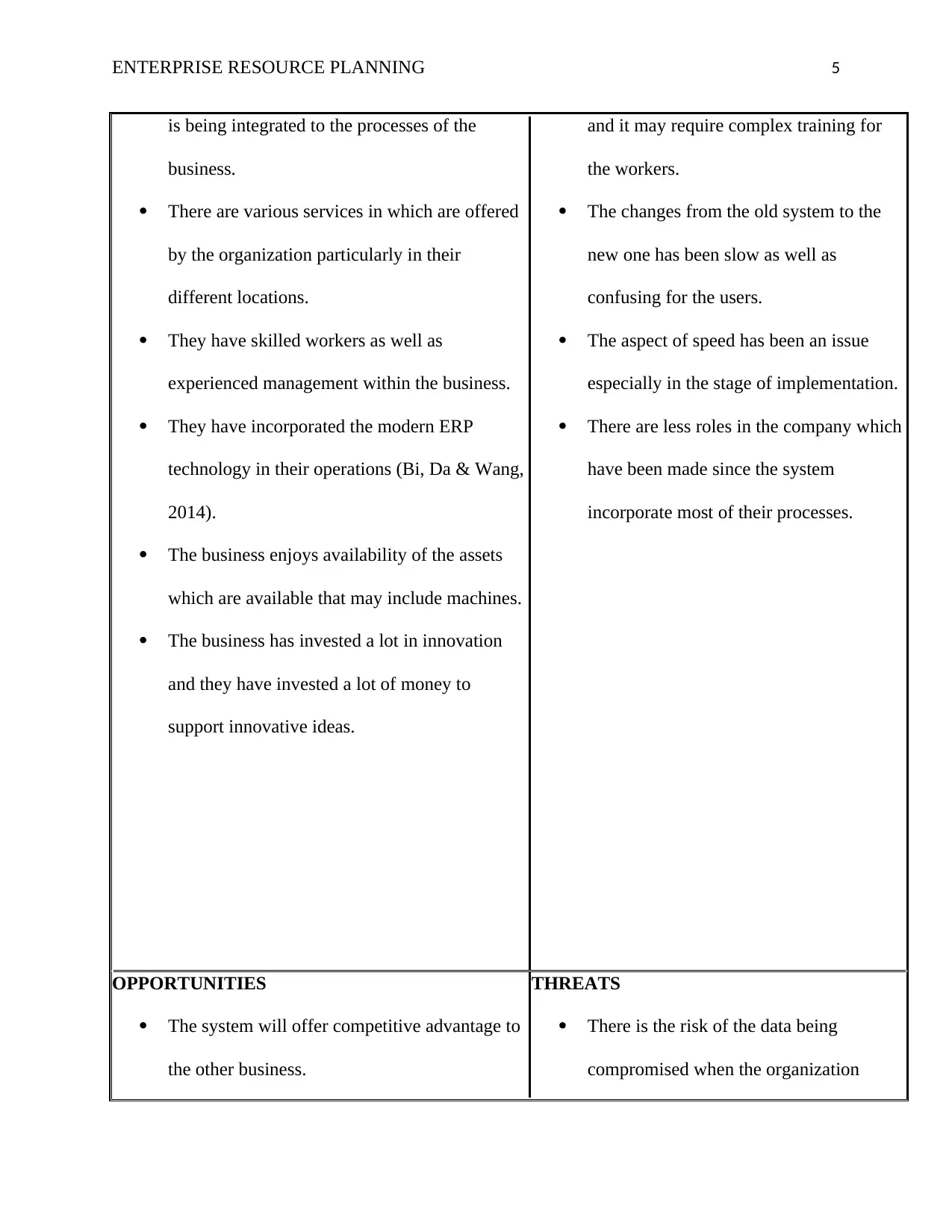
ENTERPRISE RESOURCE PLANNING 5
is being integrated to the processes of the
business.
There are various services in which are offered
by the organization particularly in their
different locations.
They have skilled workers as well as
experienced management within the business.
They have incorporated the modern ERP
technology in their operations (Bi, Da & Wang,
2014).
The business enjoys availability of the assets
which are available that may include machines.
The business has invested a lot in innovation
and they have invested a lot of money to
support innovative ideas.
and it may require complex training for
the workers.
The changes from the old system to the
new one has been slow as well as
confusing for the users.
The aspect of speed has been an issue
especially in the stage of implementation.
There are less roles in the company which
have been made since the system
incorporate most of their processes.
OPPORTUNITIES
The system will offer competitive advantage to
the other business.
THREATS
There is the risk of the data being
compromised when the organization
is being integrated to the processes of the
business.
There are various services in which are offered
by the organization particularly in their
different locations.
They have skilled workers as well as
experienced management within the business.
They have incorporated the modern ERP
technology in their operations (Bi, Da & Wang,
2014).
The business enjoys availability of the assets
which are available that may include machines.
The business has invested a lot in innovation
and they have invested a lot of money to
support innovative ideas.
and it may require complex training for
the workers.
The changes from the old system to the
new one has been slow as well as
confusing for the users.
The aspect of speed has been an issue
especially in the stage of implementation.
There are less roles in the company which
have been made since the system
incorporate most of their processes.
OPPORTUNITIES
The system will offer competitive advantage to
the other business.
THREATS
There is the risk of the data being
compromised when the organization
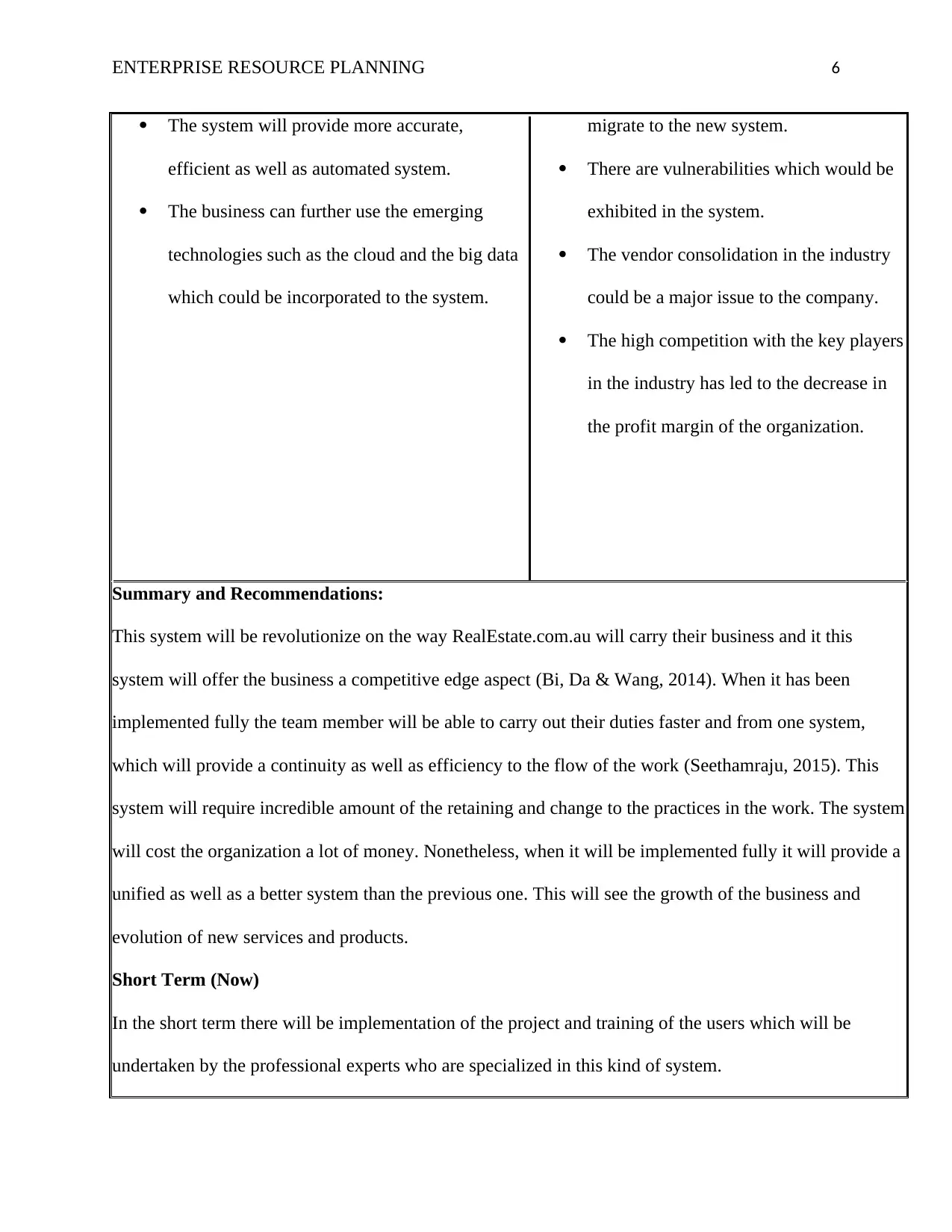
ENTERPRISE RESOURCE PLANNING 6
The system will provide more accurate,
efficient as well as automated system.
The business can further use the emerging
technologies such as the cloud and the big data
which could be incorporated to the system.
migrate to the new system.
There are vulnerabilities which would be
exhibited in the system.
The vendor consolidation in the industry
could be a major issue to the company.
The high competition with the key players
in the industry has led to the decrease in
the profit margin of the organization.
Summary and Recommendations:
This system will be revolutionize on the way RealEstate.com.au will carry their business and it this
system will offer the business a competitive edge aspect (Bi, Da & Wang, 2014). When it has been
implemented fully the team member will be able to carry out their duties faster and from one system,
which will provide a continuity as well as efficiency to the flow of the work (Seethamraju, 2015). This
system will require incredible amount of the retaining and change to the practices in the work. The system
will cost the organization a lot of money. Nonetheless, when it will be implemented fully it will provide a
unified as well as a better system than the previous one. This will see the growth of the business and
evolution of new services and products.
Short Term (Now)
In the short term there will be implementation of the project and training of the users which will be
undertaken by the professional experts who are specialized in this kind of system.
The system will provide more accurate,
efficient as well as automated system.
The business can further use the emerging
technologies such as the cloud and the big data
which could be incorporated to the system.
migrate to the new system.
There are vulnerabilities which would be
exhibited in the system.
The vendor consolidation in the industry
could be a major issue to the company.
The high competition with the key players
in the industry has led to the decrease in
the profit margin of the organization.
Summary and Recommendations:
This system will be revolutionize on the way RealEstate.com.au will carry their business and it this
system will offer the business a competitive edge aspect (Bi, Da & Wang, 2014). When it has been
implemented fully the team member will be able to carry out their duties faster and from one system,
which will provide a continuity as well as efficiency to the flow of the work (Seethamraju, 2015). This
system will require incredible amount of the retaining and change to the practices in the work. The system
will cost the organization a lot of money. Nonetheless, when it will be implemented fully it will provide a
unified as well as a better system than the previous one. This will see the growth of the business and
evolution of new services and products.
Short Term (Now)
In the short term there will be implementation of the project and training of the users which will be
undertaken by the professional experts who are specialized in this kind of system.
⊘ This is a preview!⊘
Do you want full access?
Subscribe today to unlock all pages.

Trusted by 1+ million students worldwide

ENTERPRISE RESOURCE PLANNING 7
Mid Term (next 12 months)
In this period the new system will be integrated fully to the process of the organization and the old system
which they were using previously will be removed.
Long Term (next 3 to 5 years)
During this period the organization will be adding more features as well as add on to the system to allow
it to perform all the functions in the business. This would allow the employees to access it even using
their own devices.
1.2 Role and purpose of Enterprise resource planning.
The enterprise resource planning system (ERP) are designed for the purpose of the distributors,
retailers as well as the professional services organization based on their needs (Seethamraju,
2015). The ERP are basically implemented to be able to offer more accurate data and at the same
time safe time, reduce on the costs of the assets along with the financial cycles, increase in the
satisfaction of the customers and the globally integrate the data across the organization supply
chain.
Most of the ERP system utilizes the relational database technology to be able to integrate
numerous units of the business information system that integrate all the business as well as the
sub-processes which are incorporated into the single system (Seethamraju, 2015). The ERP
system are designed to major focus on the four parts in the business; financial, marketing, human
resource and the supply chain.
Mid Term (next 12 months)
In this period the new system will be integrated fully to the process of the organization and the old system
which they were using previously will be removed.
Long Term (next 3 to 5 years)
During this period the organization will be adding more features as well as add on to the system to allow
it to perform all the functions in the business. This would allow the employees to access it even using
their own devices.
1.2 Role and purpose of Enterprise resource planning.
The enterprise resource planning system (ERP) are designed for the purpose of the distributors,
retailers as well as the professional services organization based on their needs (Seethamraju,
2015). The ERP are basically implemented to be able to offer more accurate data and at the same
time safe time, reduce on the costs of the assets along with the financial cycles, increase in the
satisfaction of the customers and the globally integrate the data across the organization supply
chain.
Most of the ERP system utilizes the relational database technology to be able to integrate
numerous units of the business information system that integrate all the business as well as the
sub-processes which are incorporated into the single system (Seethamraju, 2015). The ERP
system are designed to major focus on the four parts in the business; financial, marketing, human
resource and the supply chain.
Paraphrase This Document
Need a fresh take? Get an instant paraphrase of this document with our AI Paraphraser
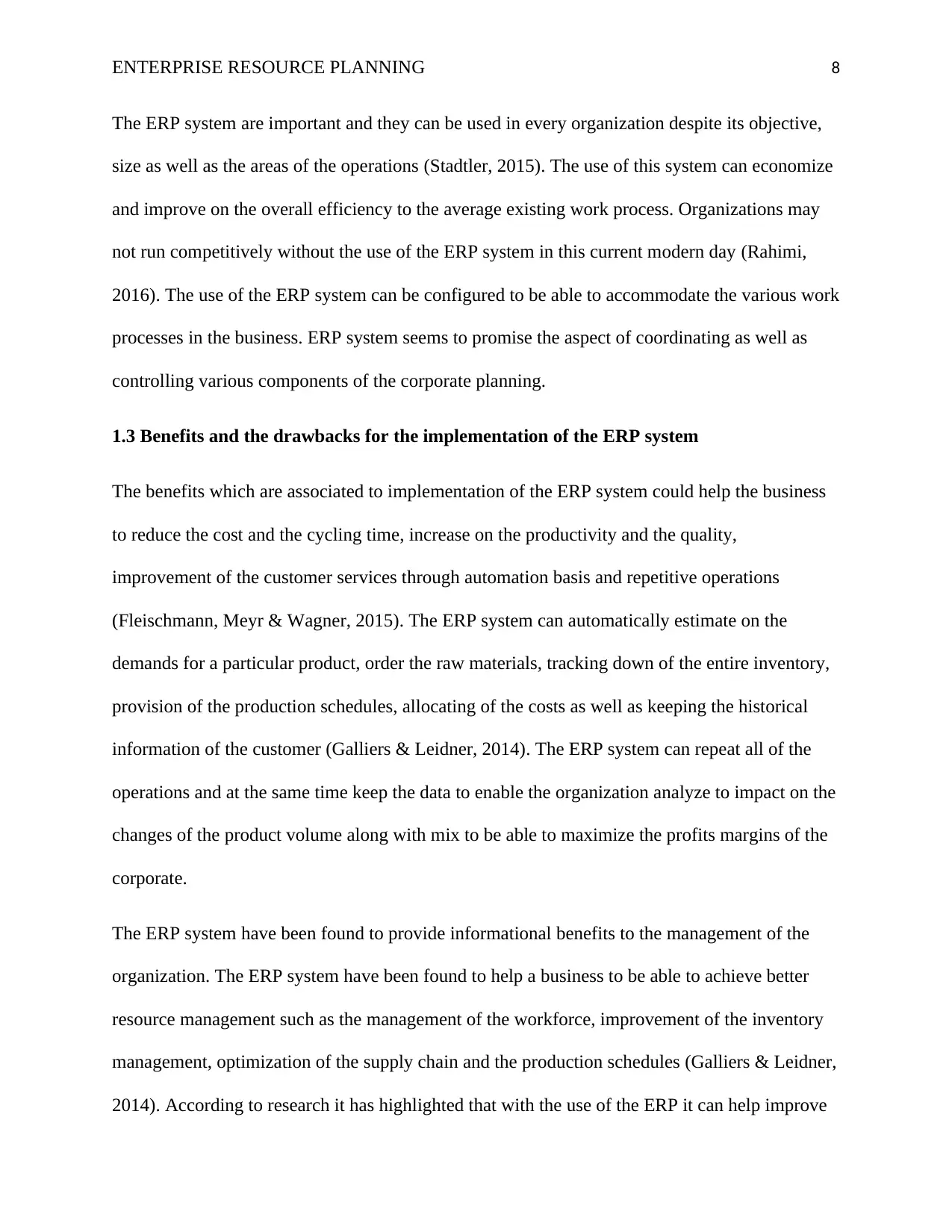
ENTERPRISE RESOURCE PLANNING 8
The ERP system are important and they can be used in every organization despite its objective,
size as well as the areas of the operations (Stadtler, 2015). The use of this system can economize
and improve on the overall efficiency to the average existing work process. Organizations may
not run competitively without the use of the ERP system in this current modern day (Rahimi,
2016). The use of the ERP system can be configured to be able to accommodate the various work
processes in the business. ERP system seems to promise the aspect of coordinating as well as
controlling various components of the corporate planning.
1.3 Benefits and the drawbacks for the implementation of the ERP system
The benefits which are associated to implementation of the ERP system could help the business
to reduce the cost and the cycling time, increase on the productivity and the quality,
improvement of the customer services through automation basis and repetitive operations
(Fleischmann, Meyr & Wagner, 2015). The ERP system can automatically estimate on the
demands for a particular product, order the raw materials, tracking down of the entire inventory,
provision of the production schedules, allocating of the costs as well as keeping the historical
information of the customer (Galliers & Leidner, 2014). The ERP system can repeat all of the
operations and at the same time keep the data to enable the organization analyze to impact on the
changes of the product volume along with mix to be able to maximize the profits margins of the
corporate.
The ERP system have been found to provide informational benefits to the management of the
organization. The ERP system have been found to help a business to be able to achieve better
resource management such as the management of the workforce, improvement of the inventory
management, optimization of the supply chain and the production schedules (Galliers & Leidner,
2014). According to research it has highlighted that with the use of the ERP it can help improve
The ERP system are important and they can be used in every organization despite its objective,
size as well as the areas of the operations (Stadtler, 2015). The use of this system can economize
and improve on the overall efficiency to the average existing work process. Organizations may
not run competitively without the use of the ERP system in this current modern day (Rahimi,
2016). The use of the ERP system can be configured to be able to accommodate the various work
processes in the business. ERP system seems to promise the aspect of coordinating as well as
controlling various components of the corporate planning.
1.3 Benefits and the drawbacks for the implementation of the ERP system
The benefits which are associated to implementation of the ERP system could help the business
to reduce the cost and the cycling time, increase on the productivity and the quality,
improvement of the customer services through automation basis and repetitive operations
(Fleischmann, Meyr & Wagner, 2015). The ERP system can automatically estimate on the
demands for a particular product, order the raw materials, tracking down of the entire inventory,
provision of the production schedules, allocating of the costs as well as keeping the historical
information of the customer (Galliers & Leidner, 2014). The ERP system can repeat all of the
operations and at the same time keep the data to enable the organization analyze to impact on the
changes of the product volume along with mix to be able to maximize the profits margins of the
corporate.
The ERP system have been found to provide informational benefits to the management of the
organization. The ERP system have been found to help a business to be able to achieve better
resource management such as the management of the workforce, improvement of the inventory
management, optimization of the supply chain and the production schedules (Galliers & Leidner,
2014). According to research it has highlighted that with the use of the ERP it can help improve
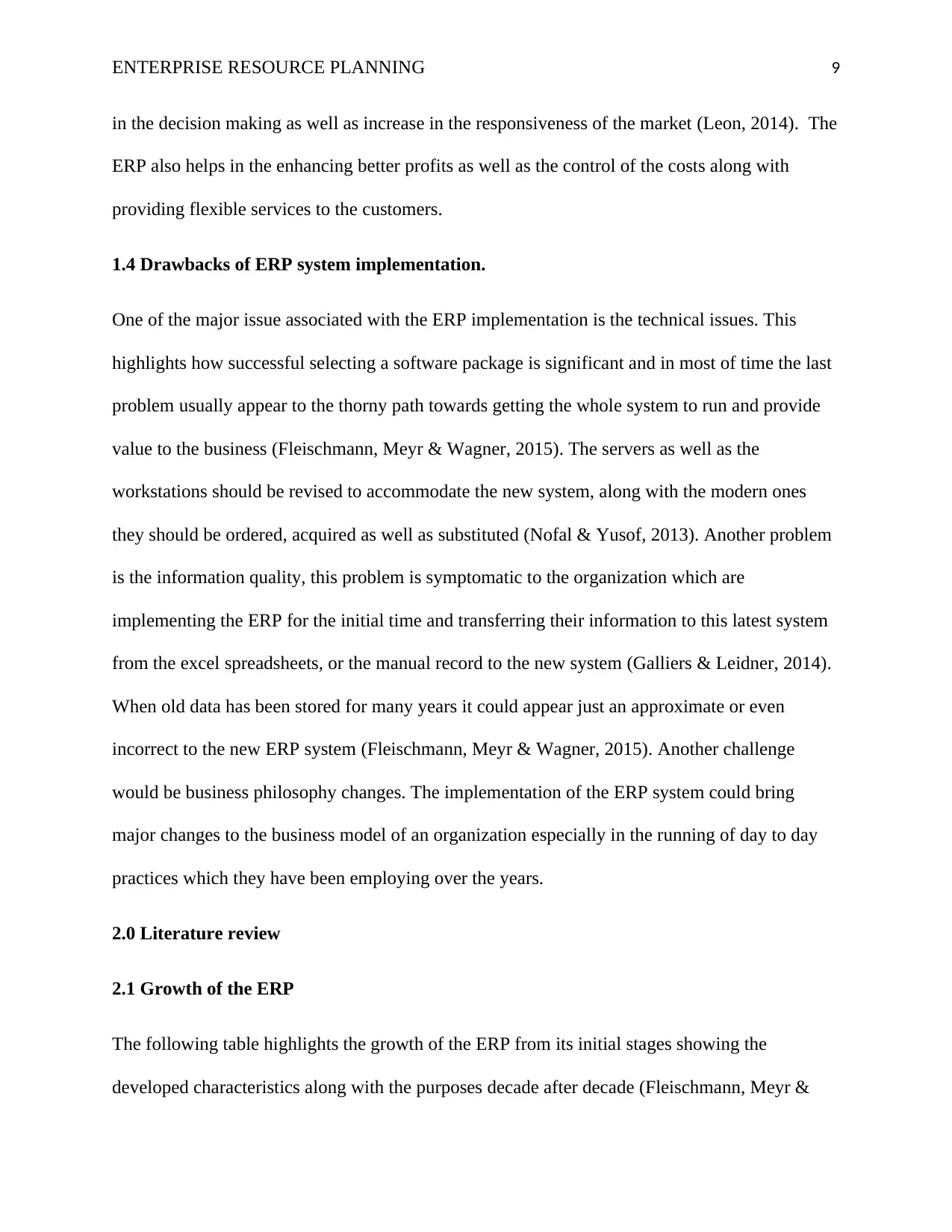
ENTERPRISE RESOURCE PLANNING 9
in the decision making as well as increase in the responsiveness of the market (Leon, 2014). The
ERP also helps in the enhancing better profits as well as the control of the costs along with
providing flexible services to the customers.
1.4 Drawbacks of ERP system implementation.
One of the major issue associated with the ERP implementation is the technical issues. This
highlights how successful selecting a software package is significant and in most of time the last
problem usually appear to the thorny path towards getting the whole system to run and provide
value to the business (Fleischmann, Meyr & Wagner, 2015). The servers as well as the
workstations should be revised to accommodate the new system, along with the modern ones
they should be ordered, acquired as well as substituted (Nofal & Yusof, 2013). Another problem
is the information quality, this problem is symptomatic to the organization which are
implementing the ERP for the initial time and transferring their information to this latest system
from the excel spreadsheets, or the manual record to the new system (Galliers & Leidner, 2014).
When old data has been stored for many years it could appear just an approximate or even
incorrect to the new ERP system (Fleischmann, Meyr & Wagner, 2015). Another challenge
would be business philosophy changes. The implementation of the ERP system could bring
major changes to the business model of an organization especially in the running of day to day
practices which they have been employing over the years.
2.0 Literature review
2.1 Growth of the ERP
The following table highlights the growth of the ERP from its initial stages showing the
developed characteristics along with the purposes decade after decade (Fleischmann, Meyr &
in the decision making as well as increase in the responsiveness of the market (Leon, 2014). The
ERP also helps in the enhancing better profits as well as the control of the costs along with
providing flexible services to the customers.
1.4 Drawbacks of ERP system implementation.
One of the major issue associated with the ERP implementation is the technical issues. This
highlights how successful selecting a software package is significant and in most of time the last
problem usually appear to the thorny path towards getting the whole system to run and provide
value to the business (Fleischmann, Meyr & Wagner, 2015). The servers as well as the
workstations should be revised to accommodate the new system, along with the modern ones
they should be ordered, acquired as well as substituted (Nofal & Yusof, 2013). Another problem
is the information quality, this problem is symptomatic to the organization which are
implementing the ERP for the initial time and transferring their information to this latest system
from the excel spreadsheets, or the manual record to the new system (Galliers & Leidner, 2014).
When old data has been stored for many years it could appear just an approximate or even
incorrect to the new ERP system (Fleischmann, Meyr & Wagner, 2015). Another challenge
would be business philosophy changes. The implementation of the ERP system could bring
major changes to the business model of an organization especially in the running of day to day
practices which they have been employing over the years.
2.0 Literature review
2.1 Growth of the ERP
The following table highlights the growth of the ERP from its initial stages showing the
developed characteristics along with the purposes decade after decade (Fleischmann, Meyr &
⊘ This is a preview!⊘
Do you want full access?
Subscribe today to unlock all pages.

Trusted by 1+ million students worldwide
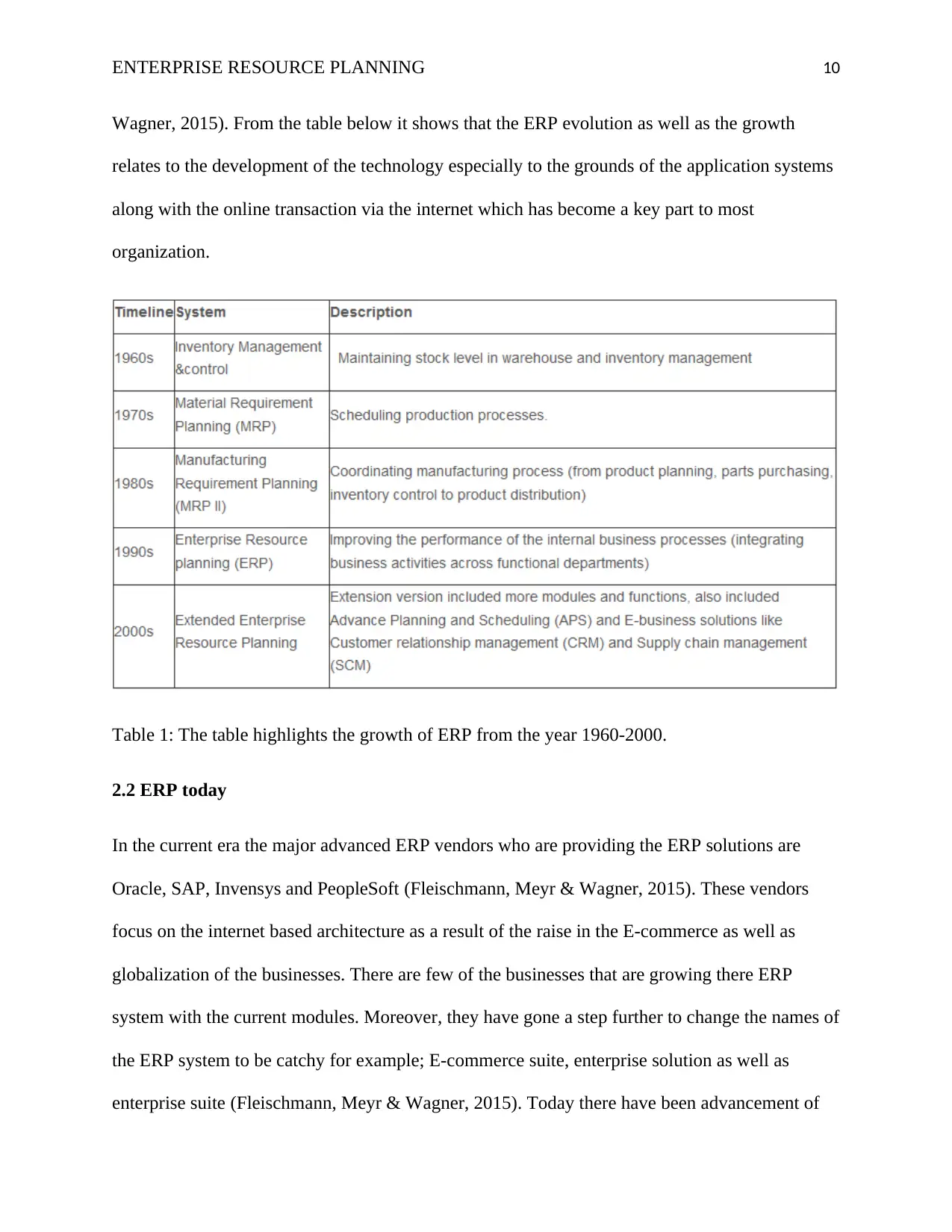
ENTERPRISE RESOURCE PLANNING 10
Wagner, 2015). From the table below it shows that the ERP evolution as well as the growth
relates to the development of the technology especially to the grounds of the application systems
along with the online transaction via the internet which has become a key part to most
organization.
Table 1: The table highlights the growth of ERP from the year 1960-2000.
2.2 ERP today
In the current era the major advanced ERP vendors who are providing the ERP solutions are
Oracle, SAP, Invensys and PeopleSoft (Fleischmann, Meyr & Wagner, 2015). These vendors
focus on the internet based architecture as a result of the raise in the E-commerce as well as
globalization of the businesses. There are few of the businesses that are growing there ERP
system with the current modules. Moreover, they have gone a step further to change the names of
the ERP system to be catchy for example; E-commerce suite, enterprise solution as well as
enterprise suite (Fleischmann, Meyr & Wagner, 2015). Today there have been advancement of
Wagner, 2015). From the table below it shows that the ERP evolution as well as the growth
relates to the development of the technology especially to the grounds of the application systems
along with the online transaction via the internet which has become a key part to most
organization.
Table 1: The table highlights the growth of ERP from the year 1960-2000.
2.2 ERP today
In the current era the major advanced ERP vendors who are providing the ERP solutions are
Oracle, SAP, Invensys and PeopleSoft (Fleischmann, Meyr & Wagner, 2015). These vendors
focus on the internet based architecture as a result of the raise in the E-commerce as well as
globalization of the businesses. There are few of the businesses that are growing there ERP
system with the current modules. Moreover, they have gone a step further to change the names of
the ERP system to be catchy for example; E-commerce suite, enterprise solution as well as
enterprise suite (Fleischmann, Meyr & Wagner, 2015). Today there have been advancement of
Paraphrase This Document
Need a fresh take? Get an instant paraphrase of this document with our AI Paraphraser

ENTERPRISE RESOURCE PLANNING 11
the ERP than the manufacturing resource planning. Presently, SAP is the global leader when it
comes to the inter-enterprise software manufacturing organization and it is the leading supplier
of the ERP globally (Laudon, 2016). To be able to have wide range of the application, SAP idea
was to offer the clients the ability to cooperate with various database in a firm and today
organization such as IBM are utilizing SAP products to run their business.
2.3 ERP process.
According to Ellis (2016), proposed various phases of the model of ERP process, these phases
are chartering, project, the shakedown, as well as the onwards and upward. When the decision of
implementation has been made, the software is then developed, configured as well as deployed
based on the requirements of the business (Fleischmann, Meyr & Wagner, 2015). In the process
of there is deployment and normal operating status of the system; there is imposing of the
controls and the system is stabilized (Fleischmann, Meyr & Wagner, 2015). The system then
moves to the normal operation status where the organization begins to utilize the ERP system
(Hoch & Dulebohn, 2013). In this model it highlights how organization should set their business
from the ERP before they can buy and implement those ERP software that are most suitable for
the obligations of the business and this can lead to better progress as well as growth of the
organization.
2.4 Key features of the ERP
The major characteristics of the ERP essentially comprise of the global financial capabilities, the
advanced planning as well as scheduling, configuration of the product, customer relationship
managements, supply chain management along with the e-commerce (Hoch & Dulebohn, 2013).
The important features of the ERP system are as follows; one of the characteristic is that ERP is
the ERP than the manufacturing resource planning. Presently, SAP is the global leader when it
comes to the inter-enterprise software manufacturing organization and it is the leading supplier
of the ERP globally (Laudon, 2016). To be able to have wide range of the application, SAP idea
was to offer the clients the ability to cooperate with various database in a firm and today
organization such as IBM are utilizing SAP products to run their business.
2.3 ERP process.
According to Ellis (2016), proposed various phases of the model of ERP process, these phases
are chartering, project, the shakedown, as well as the onwards and upward. When the decision of
implementation has been made, the software is then developed, configured as well as deployed
based on the requirements of the business (Fleischmann, Meyr & Wagner, 2015). In the process
of there is deployment and normal operating status of the system; there is imposing of the
controls and the system is stabilized (Fleischmann, Meyr & Wagner, 2015). The system then
moves to the normal operation status where the organization begins to utilize the ERP system
(Hoch & Dulebohn, 2013). In this model it highlights how organization should set their business
from the ERP before they can buy and implement those ERP software that are most suitable for
the obligations of the business and this can lead to better progress as well as growth of the
organization.
2.4 Key features of the ERP
The major characteristics of the ERP essentially comprise of the global financial capabilities, the
advanced planning as well as scheduling, configuration of the product, customer relationship
managements, supply chain management along with the e-commerce (Hoch & Dulebohn, 2013).
The important features of the ERP system are as follows; one of the characteristic is that ERP is
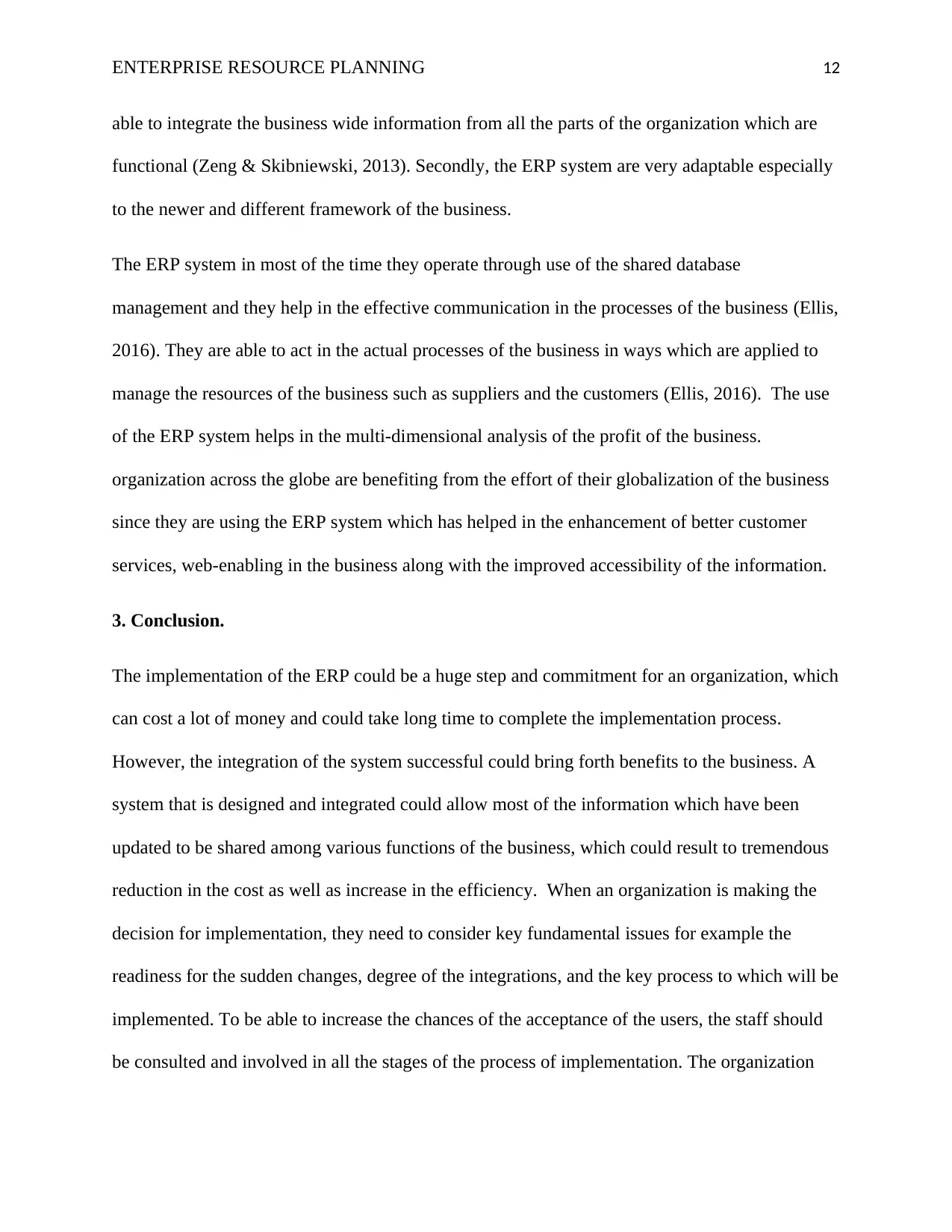
ENTERPRISE RESOURCE PLANNING 12
able to integrate the business wide information from all the parts of the organization which are
functional (Zeng & Skibniewski, 2013). Secondly, the ERP system are very adaptable especially
to the newer and different framework of the business.
The ERP system in most of the time they operate through use of the shared database
management and they help in the effective communication in the processes of the business (Ellis,
2016). They are able to act in the actual processes of the business in ways which are applied to
manage the resources of the business such as suppliers and the customers (Ellis, 2016). The use
of the ERP system helps in the multi-dimensional analysis of the profit of the business.
organization across the globe are benefiting from the effort of their globalization of the business
since they are using the ERP system which has helped in the enhancement of better customer
services, web-enabling in the business along with the improved accessibility of the information.
3. Conclusion.
The implementation of the ERP could be a huge step and commitment for an organization, which
can cost a lot of money and could take long time to complete the implementation process.
However, the integration of the system successful could bring forth benefits to the business. A
system that is designed and integrated could allow most of the information which have been
updated to be shared among various functions of the business, which could result to tremendous
reduction in the cost as well as increase in the efficiency. When an organization is making the
decision for implementation, they need to consider key fundamental issues for example the
readiness for the sudden changes, degree of the integrations, and the key process to which will be
implemented. To be able to increase the chances of the acceptance of the users, the staff should
be consulted and involved in all the stages of the process of implementation. The organization
able to integrate the business wide information from all the parts of the organization which are
functional (Zeng & Skibniewski, 2013). Secondly, the ERP system are very adaptable especially
to the newer and different framework of the business.
The ERP system in most of the time they operate through use of the shared database
management and they help in the effective communication in the processes of the business (Ellis,
2016). They are able to act in the actual processes of the business in ways which are applied to
manage the resources of the business such as suppliers and the customers (Ellis, 2016). The use
of the ERP system helps in the multi-dimensional analysis of the profit of the business.
organization across the globe are benefiting from the effort of their globalization of the business
since they are using the ERP system which has helped in the enhancement of better customer
services, web-enabling in the business along with the improved accessibility of the information.
3. Conclusion.
The implementation of the ERP could be a huge step and commitment for an organization, which
can cost a lot of money and could take long time to complete the implementation process.
However, the integration of the system successful could bring forth benefits to the business. A
system that is designed and integrated could allow most of the information which have been
updated to be shared among various functions of the business, which could result to tremendous
reduction in the cost as well as increase in the efficiency. When an organization is making the
decision for implementation, they need to consider key fundamental issues for example the
readiness for the sudden changes, degree of the integrations, and the key process to which will be
implemented. To be able to increase the chances of the acceptance of the users, the staff should
be consulted and involved in all the stages of the process of implementation. The organization
⊘ This is a preview!⊘
Do you want full access?
Subscribe today to unlock all pages.

Trusted by 1+ million students worldwide
1 out of 15
Related Documents
Your All-in-One AI-Powered Toolkit for Academic Success.
+13062052269
info@desklib.com
Available 24*7 on WhatsApp / Email
![[object Object]](/_next/static/media/star-bottom.7253800d.svg)
Unlock your academic potential
Copyright © 2020–2025 A2Z Services. All Rights Reserved. Developed and managed by ZUCOL.





